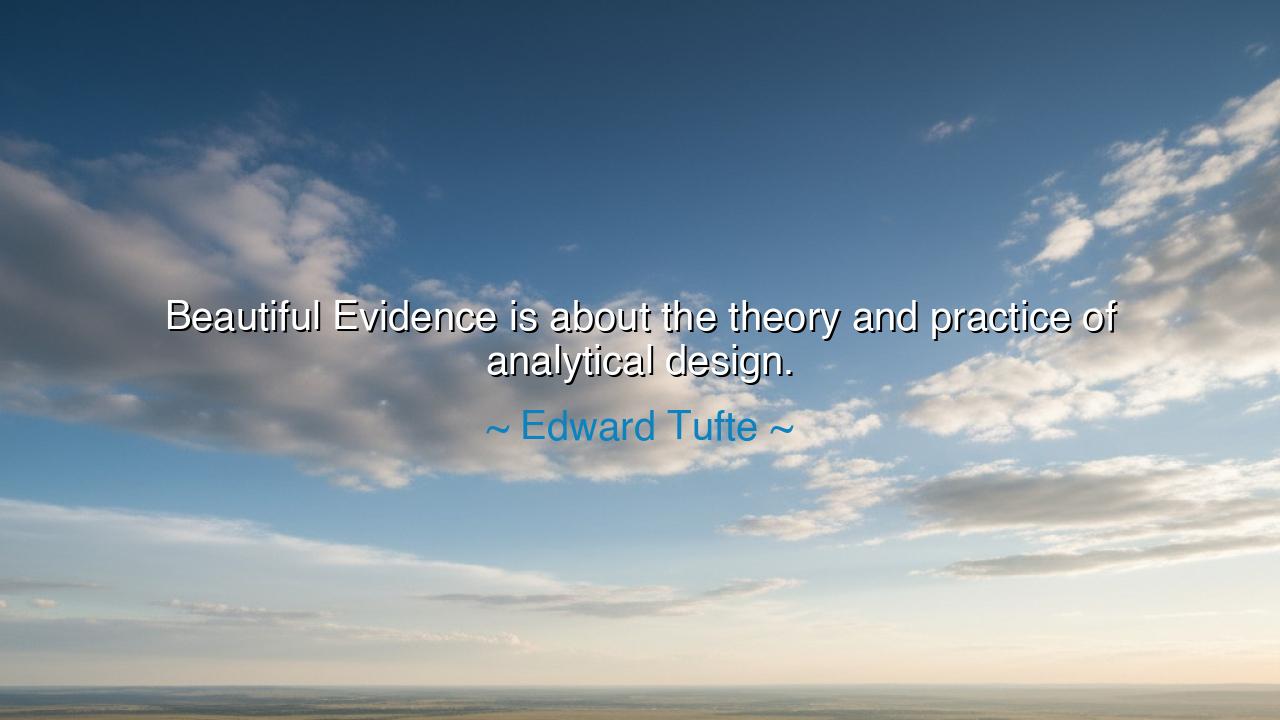
Beautiful Evidence is about the theory and practice of analytical






“Beautiful Evidence is about the theory and practice of analytical design.” Thus spoke Edward Tufte, the philosopher of information, the sculptor of truth in numbers, whose words unite two realms — beauty and reason. In this simple yet profound declaration lies the essence of his life’s work: to reveal that clarity is not cold, and that knowledge, when rightly expressed, can possess the grace of art. His statement reminds us that the pursuit of understanding need not be dry or mechanical; it can be luminous, even transcendent. For in the marriage of analysis and design, Tufte finds the key to wisdom — a way to make data not merely seen, but truly understood.
When Tufte speaks of “Beautiful Evidence,” he refers to more than his celebrated book — he speaks of a philosophy. He believes that evidence, when presented with integrity and craft, possesses an intrinsic beauty. It is not decoration that makes data beautiful, but truth illuminated — information arranged in such a way that it reveals the order of reality itself. “Analytical design,” then, is the art of shaping knowledge so that the mind may follow its pathways without confusion. In a world crowded with noise, distortion, and spectacle, this is no small task. Tufte’s creed is a call to restore dignity to the act of communication: to show the truth plainly, elegantly, and without deceit.
The origin of this quote lies in Tufte’s lifelong quest to perfect the visual language of information. Trained as a political scientist, he turned his gaze not to power, but to perception — to how numbers, words, and images could work together to form meaning. His earlier works, The Visual Display of Quantitative Information, Envisioning Information, and Visual Explanations, laid the foundation for what Beautiful Evidence would become: a synthesis of philosophy and practice, of theory and application, where clarity became an ethical pursuit. To him, the designer, scientist, and teacher all share the same duty — to help others see truth without distortion.
This ideal of merging analysis and artistry finds its echoes deep in the history of human civilization. Consider the great Leonardo da Vinci, who united mathematics and beauty in every line of his notebooks. His sketches of anatomy were not mere diagrams; they were revelations of the divine structure of life itself. Each stroke of his pen held both calculation and wonder. Or recall the work of the ancient mapmakers, who charted the stars and seas — transforming raw data into living art, where every compass rose and coastline sang of human curiosity. Like them, Tufte calls upon us to see that clarity is itself a form of grace, that the precise can be as profound as the poetic.
And yet, there is a deeper moral in his words. For Tufte’s “theory and practice of analytical design” is not limited to graphs or charts — it is a metaphor for how we might live. To live well is to design our days with purpose and proportion; to seek not excess, but elegance of mind. Just as a designer must strip away clutter to reveal the essence of information, so too must a soul remove distraction to uncover the truth of life. Whether one shapes data, art, or destiny, the principle remains: beauty arises when form serves meaning, and when action aligns with understanding.
In this way, Tufte’s teaching mirrors the wisdom of the ancients — that truth and beauty are not rivals, but companions. Plato spoke of the Good, the True, and the Beautiful as three faces of the same divine reality; Tufte, in the language of modern science, echoes that same truth. The evidence of our world, when seen rightly, is already beautiful; it does not need embellishment, only honesty. The designer’s task is to clear the path for that beauty to shine through — to make the invisible visible, the complex comprehensible, and the abstract alive.
Let this be the lesson drawn from his words: seek beauty in clarity, and clarity in beauty. When you speak, write, or create, let your design — whether of words, images, or actions — serve truth. Resist the temptation to impress when you can enlighten, or to dazzle when you can reveal. The most profound creations are those in which every element serves understanding. As Tufte teaches, the true artist of thought does not merely decorate the world — he illuminates it.
So, walk forward in the spirit of Edward Tufte, and let your work — whatever its form — become beautiful evidence. Let every act of design, every choice of word, every gesture of craft, be guided by the union of honesty and elegance. For in that union lies not only mastery, but meaning. And when truth is rendered beautifully, it becomes eternal — a light for the mind, and a gift for all who behold it.






AAdministratorAdministrator
Welcome, honored guests. Please leave a comment, we will respond soon